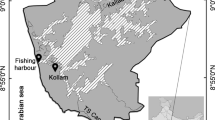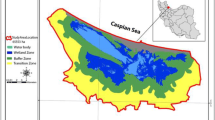Abstract
Wetlands are important for biodiversity and are critical for human livelihoods, providing ecosystem services such as clean water, food and global climate regulation. Many wetlands are threatened by land-use conversion, but creating protected areas to conserve them can benefit both biodiversity and people. However, protected areas can also have socio-economic costs for local communities. At Koshi Tappu Wildlife Reserve in Nepal, there has been historical conflict over the creation of the reserve. In light of a recent proposal to expand the protected area, we explored the use of a rapid ecosystem service assessment tool (TESSA) to assess the impact of the reserve on some of the key ecosystem services the site provides. Based on the ecosystem services assessed we estimated that the economic value of KTWR as a protected area is $350,000 y−1 ($20 ha−1y−1) less than the value of the wetland in an unprotected state. However, this difference is relatively small and is affected by the limitations of the approach and sensitivity of the values to market prices and the assumptions made, so we cannot draw clear conclusions on the overall impact of the reserve in relation to local livelihoods. However, we found TESSA to be a useful tool for engaging with the stakeholder community and for highlighting the potential impacts that land use decisions can have on key ecosystem services. In the context of informing the potential expansion of the reserve, it is clear that further intensive socio-economic assessment of the potential costs and benefits is necessary.


Similar content being viewed by others
References
Acharya KP (2003) Conserving biodiversity and improving livelihoods: The case of community forestry in Nepal. In International conference on rural livelihoods, forests and biodiversity, pp 19–23
Adams WM, Hutton J (2007) People, parks and poverty: political ecology and biodiversity conservation. Conserv Soc 5:147–183
Anderson-Teixeira KJ, DeLucia EH (2011) The greenhouse gas value of ecosystems. Glob Chang Biol 17:425–438
Bajracharya SB, Furley PA, Newton AC (2005) Effectiveness of community involvement in delivering conservation benefits to the Annapurna Conservation Area, Nepal. Environ Conserv 32(3):239–247
Balmford A, Bruner A, Cooper P, Costanza R, Farber S, Green RE, Jenkins M, Jefferiss P, Jessamy V, Madden J, Munro K et al (2002) Economic reasons for conserving wild nature. Science 297(5583):950–953
Baral HS (2005) Surveys for Lesser Adjutant Leptoptilos javanicus in and around Koshi Tappu Wildlife Reserve, Nepal. Forktail 21:190–193
Baral HS, Inskipp C (2005) Important bird areas in Nepal: key sites for conservation. Bird Conservation Nepal, Kathmandu
Baral HS, Ram AK, Chaudhary B, Basnet S, Chaudhary H, Giri TR, Chaudhary D (2012) Conservation status of Bengal Florican Houbaropsis bengalensis bengalensis (Gmelin, 1789) (Gruiformes: Otididae) in Koshi Tappu Wildlife Reserve and adjoining areas, eastern Nepal. J Threat Taxa 4(3):2464–2469
Birch JC, Thapa I, Balmford A, Bradbury RB, Brown C, Butchart SH, Gurung H, Hughes FM, Mulligan M, Pandeya B, Peh KS-H (2014) What benefits do community forests provide, and to whom? A rapid assessment of ecosystem services from a Himalayan forest, Nepal. Ecosyst Serv 8:118–127
BirdLife International (2015) Important bird areas factsheet: Koshi Tappu Wildlife Reserve and Koshi Barrage. http://www.birdlife.org. Accessed 14 Aug 2015
Brockington D, Igoe J (2006) Eviction for conservation: a global overview. Conserv Soc 4(3):424
Brockington D, Wilkie D (2015) Protected areas and poverty. Philos Trans R Soc B 370(1681):20140271
Budhathoki P (2004) Linking communities with conservation in developing countries: buffer zone management initiatives in Nepal. Oryx 38(3):334–341
Cerbu GA, Sonwa DJ, Pokorny B (2013) Forest policy and economics opportunities for and capacity barriers to the implementation of REDD+ projects with smallholder farmers: case study of Awae and Akok, Centre and South Regions, Cameroon. For Policy Econ 36:60–70. https://doi.org/10.1016/j.forpol.2013.06.018
Chettri N, Uddin K, Chaudhary S, Sharma E (2013) Linking Spatio-Temporal Land Cover Change to Biodiversity Conservation in the Koshi Tappu Wildlife Reserve, Nepal. Diversity 5:335–351
CSUWN (2009) Baseline Survey Report. Koshi Tappu Wildlife Reserve, Nepal
Dahal BR, McGowan PJK, Browne SJ (2009) An assessment of census techniques, habitat use and threats to Swamp Francolin Francolinus gularis in Koshi Tappu Wildlife Reserve, Nepal. Bird Conserv Int 19:137–147. https://doi.org/10.1017/S0959270908008083
Dahal S, Nepal SK, Schuett MA (2014) Examining marginalized communities and local conservation institutions: the case of Nepal’s Annapurna Conservation Area. Environ Manag 53(1):219–230
Dixit A (2009) Kosi embankment breach in Nepal: Need for a paradigm shift in responding to floods. Econ Polit Wkly 7(6):70–78
DNPWC (2011) Annual Report 2067/68 Koshi Tappu Wildlife Reserve. DNPWC, West Kusaha
FAO (2008) Country pasture/forage resource profiles, Nepal. FAO, Rome
Finlayson CM, Davidson NC, Spiers AG, Stevenson NJ (1999) Global wetland inventory—current status and future priorities. Mar Freshw Res 50(8):717–727
Goit RK, Basnet K (2011) Status and conservation of crocodiles in the Koshi Tappu Wildlife Reserve, eastern Nepal. J Threat Taxa 3(8):2001–2010
Government of Nepal (2016) Nepal Tourism Statistics 2015. Ministry of Culture, Tourism & Civil Aviation, Kathmandu
Government of Nepal, DNPWC (2009) Koshi Tappu Wildlife Reserve and Buffer Zone Management Plan (2009–2013). Government of Nepal, Ministry of Forests and Soil Conservation Department of National Parks and Wildlife Conservation Koshi Tappu Wildlife Reserve, Kathmandu
Gram S (2001) Economic valuation of special forest products: an assessment of methodological shortcomings. Ecol Econ 36(1):109–117
Greenspan Bell R, Callan D (2011) More than meets the eye: the social cost of carbon in U.S. climate policy, in plain English. Policy brief. World Resources Institute, Washington
Hedges S, Sagar Baral H, Timmins RJ, Duckworth JW (2008) Bubalus arnee. The IUCN Red List of Threatened Species. Version 2015.2. www.iucnredlist.org. Accessed 14 Aug 2015
Heinen JT (1993a) Park—people relations in Kosi Tappu Wildlife Reserve, Nepal: a socio-economic analysis. Environ Conserv 20(1):25–34
Heinen JT (1993b) Population viability and management recommendations for wild water buffalo Bubalus bubalis in Kosi Tappu Wildlife Reserve, Nepal. Biol Conserv 65(1):29–34
Heinen JT, Kattel B (1992) Parks, people, and conservation: a review of management issues in Nepal’s protected areas. Popul Environ 1(14):49–84
ICIMOD, MoFSC (2014) An integrated assessment of the effects of natural and human disturbances on a wetland ecosystem: a retrospective from the Koshi Tappu Wildlife Reserve. ICIMOD, Kathmandu
International Monetary Fund (2012) World Economic Outlook Database, October 2012. http://www.imf.org/external/pubs/ft/weo/2012/02/weodata/index.aspx. Accessed 14 Nov 2012
John FA, Edwards-Jones G, Gibbons JM, Jones JP (2010) Testing novel methods for assessing rule breaking in conservation. Biol Conserv 143(4):1025–1030
Jones T (1993) A directory of wetlands of international importance: sites designated for the Ramsar List of Wetlands of International Importance. IUCN, Gland
Kettunen M, Ten Brink P (2013) The social and economic benefits of protected areas: an assessment guide. Routledge, Abingdon
Khatri TB, Shah DN, Shah RD, Mishra N (2011) Biodiversity of Koshi Tappu Wildlife Reserve: a post flood assessment. J Wetl Ecol 7(4):69–82
Khatri TB, Shah DN, Mishra N (2012) Wild Water Buffalo Bubalus arnee in Koshi Tappu Wildlife Reserve, Nepal: status, population and conservation importance. J Threat Taxa 4(14):3294–3301
Lasgorceix A, Kothari A (2009) Displacement and relocation of protected areas: a synthesis and analysis of case studies. Econ Polit Wkly XLIV:37–47
Mcinnes RJ, Everard M (2017) Rapid Assessment of Wetland Ecosystem Services (RAWES): an example from Colombo, Sri Lanka. Ecosyst Serv 25:89–105. https://doi.org/10.1016/j.ecoser.2017.03.024
McLean J, Straede S (2003) Conservation, Relocation, and the paradigms of park and people management—a case study of Padampur villages and the Royal Chitwan National Park, Nepal. Soc Nat Resour 16(6):509–526
Menton MC, Lawrence A, Merry F, Brown ND (2010) Estimating natural resource harvests: conjectures? Ecol Econ 69(6):1330–1335
Ministry of Agricultural Development (2012) Statistical information on Nepalese agriculture 2011/2012. Government of Nepal, Kathmandu
Mitsch WJ, Gosselink JG (2000) The value of wetlands: importance of scale and landscape setting. Ecol Econ 35(1):25–33. https://doi.org/10.1016/S0921-8009(00)00165-8
Peh KS-H, Balmford AP, Bradbury RB, Butchart SHM, Brown C, Hughes FMR, Stattersfield AJ, Thomas DHL, Walpole M, Birch JC (2013a) Toolkit for Ecosystem Service Site-based Assessment (TESSA). Cambridge, UK
Peh KS-H, Balmford A, Bradbury RB, Brown C, Butchart SH, Hughes FM, Stattersfield A, Thomas DH, Walpole M, Bayliss J, Gowing D et al (2013b) TESSA: a toolkit for rapid assessment of ecosystem services at sites of biodiversity conservation importance. Ecosyst Serv 5:51–57
Peh KS-H, Thapa I, Basnyat M, Balmford A, Bhattarai GP, Bradbury RB, Brown C, Butchart SHM, Dhakal M, Gurung H, Hughes FMR, Mulligan M, Pandeya B, Statterfield AJ, Thomas DHL, Walpole M, Merriman JC (2016) Synergies between biodiversity conservation and ecosystem service provision: lessons on integrated ecosystem service valuation from a Himalayan protected area, Nepal. Ecosyst Serv 22:359–369
Rayamajhi B (2009) Direct use values of wetland resources to inhabitants in the buffer zone of Koshi Tappu Wildlife Reserve, Nepal. Dissertation, Master of Science, Mahidol University
Russi D, ten Brink P, Farmer A, Badura T, Coates D, Förster J, Kumar R, Davidson N (2013) The economics of ecosystems and biodiversity for water and wetlands. IEEP, London and Brussels
Shakya I, Baral H, Lenoci J (2013) Terminal Evaluation Report, Conservation and Sustainable Use of Wetlands in Nepal (CSUWN). UNDP and MoFSC, Kathmandu
Sharma B, Rasul G, Chettri N (2015) The economic value of wetland ecosystem services: evidence from the Koshi Tappu Wildlife Reserve, Nepal. Ecosystem Services 12:84–93
Shrestha RK, Alavalapati JR, Seidl AF, Weber KE, Suselo TB (2007) Estimating the local cost of protecting Koshi Tappu Wildlife Reserve, Nepal: a contingent valuation approach. Environ Dev Sustain 9(4):413–426
Stern NH (2006) Stern review: the economics of climate change. HM Treasury, London
Thapa I, Dahal BR (2009) Sustainable wetland management for wildlife and people at Koshi Tappu Wildlife Reserve. Banko Janakari 19(3):36–39
Tol RS (2010) The economic impact of climate change. Perspektiven der Wirtschaftspolitik 11(s1):13–37
UNEP-WCMC and IUCN (2016) Protected Planet Report 2016. UNEP-WCMC and IUCN, Cambridge
UNWWAP (2003) Water for people, water for life. http://www.unesco.org/new/en/natural-sciences/environment/water/wwap/wwdr/wwdr1-2003/downloads/. Accessed 10 May 2013
West P, Igoe J, Brockington D (2006) Parks and peoples: the social impact of protected areas. Annu Rev Anthropol 35:251–277
World Bank (2013) Operational manual OP4.12—involuntary resettlement. https://policies.worldbank.org/sites/ppf3/PPFDocuments/090224b0822f89db.pdf. Accessed 16 Aug 2017
Acknowledgements
This work was funded by the UK Darwin Initiative (contract 18-005). The ecosystem service assessment methodologies in TESSA used for this study were developed by BirdLife International, University of Cambridge, UNEP-World Conservation Monitoring Centre, Anglia Ruskin University and the Royal Society for the Protection of Birds, and involved input from more than 30 UK and international experts who attended a workshop in May 2010. We thank Andy Graham, Menuka Basnyat and Chandra Chaudhary for their assistance with fieldwork and Seb Buckton for his guidance at the outset of this work. We also thank Renu Sah of the Buffer Zone Management Council, the Buffer Zone User Committee representatives of Prakashpur, Madhuban, Bairwara, Badgama, Odaraha, Dharampur, Tapeshwori, Kushaha, Rabin Ghimire of UCHEP-NEPAL and Vivekananda Jha from the Conservation and Sustainable Use of Wetlands, Nepal UNDP/GEF project for their support with this research. Thanks to Andy Graham for his comments on an early draft of this paper and to two anonymous reviewers.
Funding
This work was funded by the UK Darwin Initiative (contract 18-005) from 2010 to 2013. http://www.darwininitiative.org.uk/project/18005/.
Author information
Authors and Affiliations
Corresponding author
Electronic supplementary material
Below is the link to the electronic supplementary material.
Rights and permissions
About this article
Cite this article
Merriman, J.C., Gurung, H., Adhikari, S. et al. Rapid ecosystem service assessment of the impact of Koshi Tappu Wildlife Reserve on wetland benefits to local communities. Wetlands Ecol Manage 26, 491–507 (2018). https://doi.org/10.1007/s11273-017-9587-2
Received:
Accepted:
Published:
Issue Date:
DOI: https://doi.org/10.1007/s11273-017-9587-2




